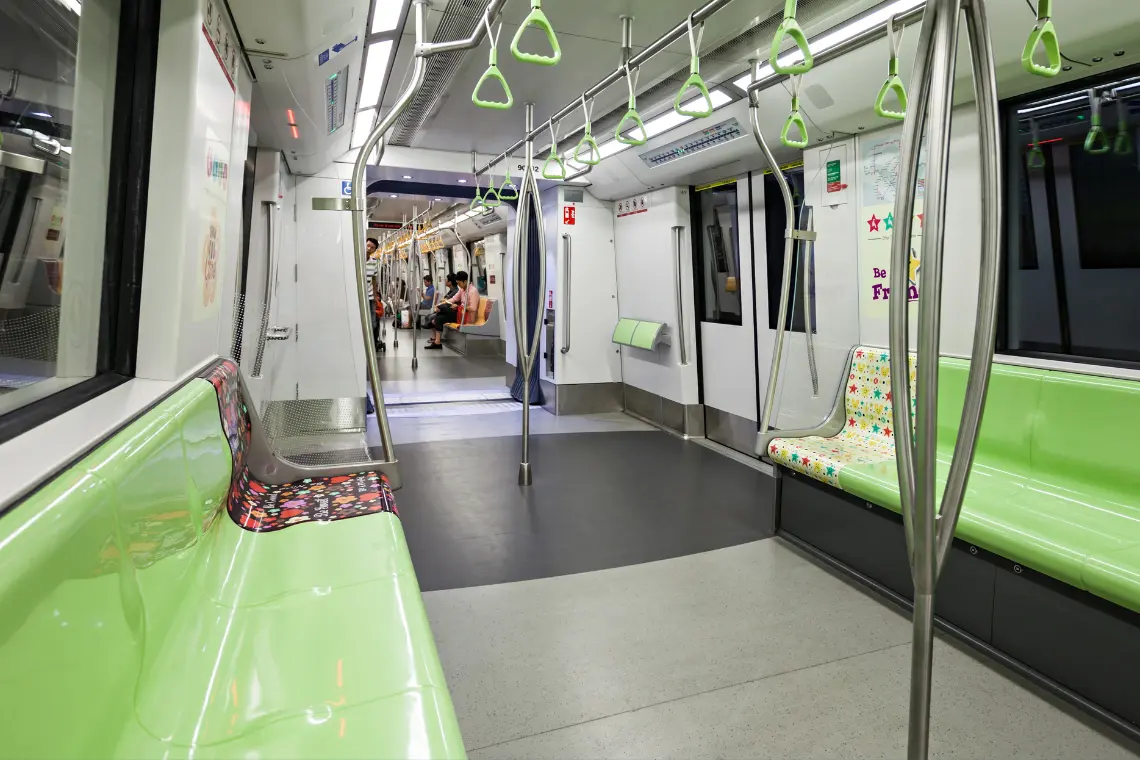Life on the road, or more accurately, life on the cloud—that’s the allure of the digital nomad lifestyle.
As internet technology grows exponentially, so does the tribe of those who work while they wander, carrying their offices in their backpacks.
But, as we travel and explore, we must consider our impact on the world we so cherish. That’s where sustainable travel comes into the picture 
In this guide, we delve into the concept of sustainable travel for digital nomads, from practices to destinations and handy tools.
But before we get into the details, let’s understand why it’s so important.
Importance of Sustainable Travel

Sustainable travel is all about making simple choices to lessen your negative impact on a destination.
For digital nomads, who are always on the move, this is even more significant.
After all, the places we fall in love with during our travels are the ones we should strive to protect.
With each place we visit, we consume resources and produce waste.
Over time and across many travelers, this can put enormous strain on local environments and communities.
As digital nomads, we have the power (and responsibility) to minimize this impact, supporting the long-term health of the places we visit.
Top Sustainable Travel Practices

Transitioning into a more sustainable lifestyle while traversing the globe might seem daunting at first, but it doesn’t have to be.
By implementing some simple practices, you can significantly reduce your environmental impact and contribute positively to the places you visit.
1. Minimizing Carbon Footprint 
Choosing eco-friendly transportation: Rather than relying on taxis or rented cars, consider using public transportation systems, renting a bike, or even walking.
Not only will these choices reduce your carbon emissions, but they also offer a more authentic experience of your locale. For longer travel, consider trains over planes.
If you must fly, direct flights are preferable, as takeoffs and landings are the most fuel-intensive parts of a flight.
Offsetting carbon emissions: While eliminating carbon emissions from travel is challenging, offset programs can balance the scales.
Various airlines, travel companies, and NGOs offer carbon offset schemes.
These programs calculate your travel emissions, allowing you to finance projects that reduce CO2 emissions in other areas.
This could be anything from reforestation to renewable energy projects.
2. Sustainable Accommodation 
Choosing green hotels or guesthouses: Sustainable accommodation doesn’t mean compromising on comfort.
Many eco-friendly establishments are dedicated to offering excellent services.
They commit to responsible practices like energy efficiency, water conservation, waste reduction, and the use of renewable energy sources.
Homestays, work exchanges, and house-sitting: Immerse yourself in local culture through homestays, exchange work for lodging, or consider house-sitting.
These alternatives not only reduce your environmental impact but also foster deeper connections with local communities.
3. Responsible Consumption 
Eating and shopping locally: Savour local cuisine and buy local products.
This supports the local economy and reduces carbon emissions related to the shipping of goods.
Plus, you will enjoy authentic experiences that mass-produced items can’t offer.
Minimizing waste and recycling: Single-use items contribute significantly to global waste.
Consider packing reusable items like water bottles, shopping bags, coffee cups, and cutlery. When recycling facilities are available, attempt to recycle.
4. Digital Responsibility 
Using digital tools that offset carbon emissions: Several online platforms, such as Ecosia, a search engine that plants trees with its revenue, help you offset carbon emissions.
Integrating such tools into your daily routine can make a significant difference.
Efficient use of digital devices: Power usage can add up. Remember to turn off devices when not in use; this saves energy.
Also, unplug chargers, as they draw power even when not charging, and opt for eco-friendly alternatives like solar-powered chargers.
Integrating Sustainability into Work Practices

Our work and how we conduct it form a significant part of our overall environmental impact, especially for digital nomads.
Here are some ways you can align your work practices with sustainability:
Co-working spaces: Working from a co-working space can be more energy-efficient than working from a coffee shop or your accommodation.
Many co-working spaces also offer a sense of community, giving you a chance to network with other professionals and share ideas about sustainability.
Digital services with a sustainability focus: When choosing digital services—like web hosting, cloud storage, or digital marketing tools—opt for companies that make sustainability a priority.
Promoting sustainable products and services: As a digital nomad, you may have a blog, YouTube channel, or social media presence.
Use these platforms to promote products and services that contribute to sustainable living.
This approach helps these businesses grow while also raising sustainability awareness among your audience.
It fosters a broader environmental impact, extending beyond mere business growth.
Best Destinations for Sustainable Living

Sustainability isn’t only about our personal choices; it’s also influenced by the places we visit.
Some cities and countries have already set impressive benchmarks in sustainability, making them ideal choices for digital nomads who care for the planet.
Here are a few you might consider:
Copenhagen, Denmark: Ranked as the world’s greenest city multiple times. Copenhagen aims to become carbon-neutral by 2025.
With excellent public transportation, many bike paths, and a strong focus on renewable energy, this city is a sustainable digital nomad’s dream.
Vancouver, Canada: Known for its green spaces and commitment to clean energy, Vancouver offers a great mix of city life and nature.
The city’s Greenest City 2020 Action Plan is an initiative towards becoming the greenest city in the world.
Singapore: Despite its small size, Singapore is a leader in green urban planning. Known as the ‘Garden City’, it offers a high quality of life, excellent co-working spaces, and strong environmental regulations.
Berlin, Germany: With many eco-friendly neighbourhoods, a robust recycling program, and a thriving organic food scene, Berlin is a top spot for green living.
Costa Rica: If you prefer a tropical setting, Costa Rica, known for its rich biodiversity, has a firm commitment to sustainability. It aims to become the world’s first carbon-neutral country by 2021.
Tools and Resources for Sustainable Travel

Technology has become a game-changer in how we navigate the world, and this includes our efforts towards more sustainable living and travel.
There are many apps and websites that are specifically made to help digital nomads become more environmentally friendly.
EcoBnb: EcoBnb is a platform dedicated to connecting travelers with eco-friendly and nature-friendly accommodations across the globe.
EcoBnb simplifies the process for conscious travellers to find and book sustainable accommodations.
The platform caters to various preferences, offering options ranging from off-grid small homes to luxury eco-lodges and organic farm stays.
My Little Plastic Footprint: This app helps you reduce your plastic consumption.
My Little Plastic Footprint allows users to take a plastic test, calculate their plastic footprint, and learn about alternatives to common plastic items.
It’s an interactive way to get insights into your plastic usage and discover practical ways to minimize it.
BlaBlaCar: If you’re looking for a green alternative to conventional long-distance travel, BlaBlaCar is your go-to solution.
This long-distance ridesharing service connects drivers traveling from one city to another with travelers headed the same way.
Not only is it an economical choice, but sharing rides significantly reduces CO2 emissions compared to traveling solo.
HappyCow: For the eco-conscious foodie, HappyCow is a must-have.
This online service is a comprehensive guide to vegan and vegetarian restaurants around the world.
It can help you discover local plant-based dining options, promote healthier diets, and reduce meat consumption, both of which are crucial for environmental sustainability.
Green Globe: To make your travel planning more sustainable, Green Globe provides certification for sustainable tourism.
The app helps you find certified sustainable travel services, including accommodations, cruises, tour operators, and attractions, around the world.
They committed to the certification guarantees that these businesses make positive contributions to people, the planet, and prosperity.
Learn from Sustainable Digital Nomads

Not only is the idea of sustainable travel an idea, but many people in the digital nomad community actually live by it.
These examples showcase individuals who are not only embracing this lifestyle but are also actively contributing to a more sustainable world.
Nikki and David: Pioneers of Eco-Conscious Travel Blogging
Nikki and David, a dynamic entrepreneurial duo, have taken the digital nomad lifestyle to new heights through their commitment to sustainable travel.
On their popular blog, Nikki and David offer detailed accounts of their travels.
They focus on making environmentally conscious decisions while immersing themselves in diverse cultures.
What sets them apart is their dedication to promoting sustainable practices in each place they visit.
They actively collaborate with local communities, supporting various eco-friendly initiatives.
Their efforts include participating in beach clean-ups and volunteering for wildlife conservation projects.
Their blog is not just a travel diary; it’s a resource for those looking to combine work and travel with an earnest commitment to the planet.
Katie Patrick: Engineering a Greener Future
Katie Patrick stands out as an exemplary figure in the world of sustainable digital nomadism.
As an environmental engineer and software designer, Katie brings a unique blend of technology and environmental activism to her nomadic lifestyle.
She develops software tools that help businesses and individuals track and reduce their carbon footprints.
Her work extends beyond personal lifestyle changes, aiming to make a broader impact through technological solutions.
Living as a digital nomad, Katie leverages her travels to gain insights into global environmental challenges and collaborates with international teams on green projects.
Her story shows how having tech skills and caring about the environment can work together to make a big difference.
Beyond Just Travel

Both of these examples illustrate that sustainable travel for digital nomads is more than just about being on the move; it’s about making a positive impact wherever they go.
Nikki and David’s commitment to responsible tourism and Katie’s use of her professional skills for environmental change highlight a key aspect of sustainable travel.
It’s not only about personal experiences but equally about the positive contributions one makes to the places visited.
These digital nomads are not just tourists; they are environmental ambassadors, using their mobility to spread awareness and foster change.
Through their stories, we learn that sustainable travel in the digital nomad community isn’t just a fleeting trend; it’s a growing movement.
It’s about conscious choices and actions that create a ripple effect, inspiring others to consider their environmental footprint as they explore the world.
Conclusion
Digital nomads can not only see the world and work in the most interesting places, but they can also make sure that those places stay alive and healthy for future generations by travelling in a way that doesn’t harm the environment.
After all, isn’t it worth preserving the world in which we so love to wander?
So, as we pack our bags and laptops, let’s commit to making more sustainable choices for the love of travel, work, and our planet.
FAQs
Sustainable travel involves making choices that contribute to the conservation of the environment and the well-being of local communities in the places we visit. It includes practices like reducing waste, minimizing carbon emissions, respecting local cultures, and supporting local economies.
As individuals who often move from place to place, digital nomads have a unique opportunity to contribute positively to a wide variety of environments and cultures. By adopting sustainable practices, they can help conserve the very places that inspire and nourish them.
Digital nomads can practice sustainable travel by choosing eco-friendly transportation, opting for sustainable accommodation, being mindful of their consumption, and incorporating sustainability into their work practices.
Some cities and countries that are known for their sustainability efforts include Copenhagen, Denmark; Vancouver, Canada; Singapore; Berlin, Germany; and Costa Rica.
Yes, there are several apps and websites such as EcoBnb, My Little Plastic Footprint, BlaBlaCar, HappyCow, and Green Globe that can assist with various aspects of sustainable travel.
Yes, entrepreneurs and travel bloggers like Nikki and David, and environmental engineer Katie Patrick, are excellent examples of individuals who’ve successfully integrated sustainable practices into their digital nomad lifestyles.
Related Posts
Note: Some links on this page might be affiliate links. If you make a purchase through these links, I may earn a small commission at no extra cost to you. Thanks for your support!

















